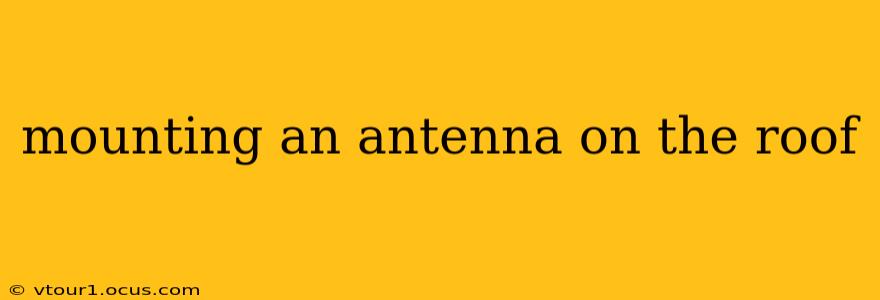Mounting an antenna on your roof can significantly improve your TV reception or expand your wireless network's reach. However, it's a project that requires careful planning and execution to ensure safety and effectiveness. This guide provides a comprehensive overview of the process, addressing common concerns and questions.
What Type of Antenna Am I Mounting?
Before you even think about ladders and tools, you need to identify the type of antenna you're working with. Different antennas have different mounting requirements and weight considerations. Are you installing a TV antenna, a satellite dish, a cellular antenna, or a Wi-Fi antenna? Each requires a unique approach. For example, a large satellite dish needs a much stronger mounting system than a small TV antenna. Understanding your antenna's specifications – weight, dimensions, and wind load resistance – is crucial for selecting the appropriate mounting hardware.
What Tools and Materials Will I Need?
The tools and materials required will vary depending on the type of antenna and your roof's material. However, some essentials include:
- Ladder: A sturdy ladder that extends several feet beyond the roofline is essential for safe access. Consider using a ladder stabilizer for added security.
- Drill: A powerful drill with appropriate drill bits for your roof material (e.g., wood, metal, composite shingles).
- Screwdrivers: Various screwdrivers to match the screws included with your antenna and mounting bracket.
- Measuring Tape: For accurate placement and measurements.
- Level: Essential for ensuring the antenna is properly aligned.
- Caulk: To seal around the mounting bracket and prevent leaks.
- Safety Gear: This is paramount! Always wear safety glasses, work gloves, and appropriate footwear. A safety harness is highly recommended, particularly for sloped roofs.
- Mounting Bracket: Choose a bracket appropriate for your antenna and roof type.
- Appropriate Fasteners: Use fasteners designed for your roof material.
How Do I Choose the Right Mounting Location?
Choosing the right location is crucial for optimal signal reception. For TV antennas, consider the following:
- Line of Sight: Ensure a clear line of sight to the broadcast towers. Obstructions like trees or buildings will significantly reduce signal strength.
- Height: Higher generally means better reception, but safety should always be the top priority.
- Wind Exposure: Consider the wind conditions in your area. A high-wind location might require a more robust mounting system.
- Roof Access: Choose a location that is safely accessible with your ladder and equipment.
How Do I Securely Mount the Antenna?
This is where precise execution and safety are paramount. Follow these steps:
- Mark the Mounting Location: Use a level to ensure accurate placement.
- Drill Pilot Holes: Drill pilot holes to prevent splitting your roof material.
- Secure the Mounting Bracket: Attach the bracket firmly using appropriate fasteners. Always double-check your work.
- Mount the Antenna: Carefully attach the antenna to the mounting bracket, following the manufacturer's instructions.
- Caulk and Seal: Apply caulk around the mounting bracket to prevent water leakage.
What Are the Potential Risks and How Can I Mitigate Them?
Working on a roof inherently carries risks. Here are some precautions:
- Never work alone: Always have a spotter to assist.
- Use a safety harness: This is crucial for sloped roofs.
- Check the weather: Do not work in inclement weather.
- Inspect your equipment: Ensure all your tools and equipment are in good working order.
- Be aware of power lines: Maintain a safe distance from overhead power lines.
What Happens If My Roof is Damaged During Installation?
Accidents can happen. If you damage your roof during installation, contact a qualified roofing professional immediately to assess the damage and make necessary repairs. Delaying repairs could lead to more extensive and costly problems.
How Much Does it Cost to Mount an Antenna on a Roof?
The cost varies depending on the type of antenna, the complexity of the installation, and the materials used. You can save money by performing the installation yourself, but hiring a professional installer provides peace of mind and ensures a safe and properly executed job.
Can I Mount an Antenna Myself, or Should I Hire a Professional?
While DIY installation is possible for many, hiring a professional installer offers several advantages: safety, expertise, warranty coverage, and peace of mind. If you are uncomfortable working at heights or lack experience with roof repairs, it's best to hire a professional.
This comprehensive guide provides a strong foundation for safely and effectively mounting your antenna. Remember, safety should always be your top priority. If you have any doubts about your ability to complete this project safely, seek professional assistance.
